How to Read a Garmin Fish Finder
For beginners in kayak fishing, one of the almost frequently asked questions is, "How do I read a Fish Finder Screen?" If this is you, we have got your back on this.
In this article, we are going to show you how to read a fishfinder screen to assistance you go a better angler.
Agreement and Interpreting the display
While fishfinders are nifty for letting you run into what's underneath your boat, they also allow you to have a clear view of how fish responds to your bait and help you spot where fish congregate.
Most fishfinders use sonar engineering to shoot a axle straight down to create an image in the h2o. In return, they give you a SMALL corporeality of bottom coverage. Fifty-fifty though the Sonar coverage isn't going to requite you lot the most event, you tin can still read the screen sonar effectively just past applying a few tricks.
Identifying Fish
The first affair you need to learn is how to identify fish. For fishfinders with Fish-ID applied science, identifying fish can be a cakewalk. This engineering converts the raw data gotten from the water into a user-friendly interface to help you interpret what is below you.
Fish Icons
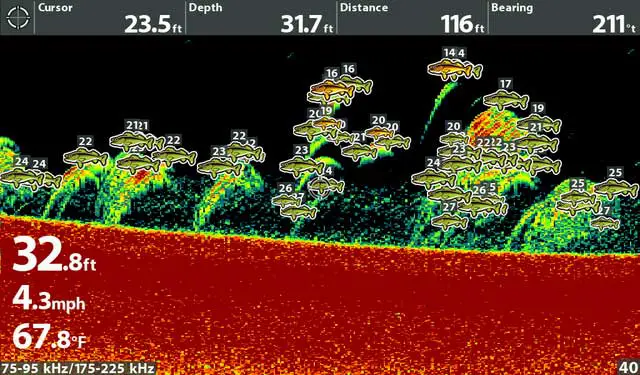
The Fish-ID engineering science type of fishfinder will help you locate tiny fish icons. Yous will get to see them in different sizes and lengths. The best part is that y'all can also view different icons for plants, rocks, and schools of fish.
What is required of you is just to read the Icon displayed on your screen and understand the depth of the displayed icon?
However, you need to be a little bit cautious with this; almost Fish-IDs do come with their own downsides. Most times, what your Fish ID will brandish as a school of fish might plow out to be a grouping of plants after you have bandage in your internet. But with frequent practice, you will go the hang of how to use them finer.
Fish Arches
If yous take an arch fishfinder, so expect to be receiving lines and arches from the transducer. This type of fishfinder will salve you a lot of time once you understand how they work.
They stand for fish as arches more clearly than Fish IDs. And then when your fishfinder shows bigger arches, it means it has detected a big fish, while minor arch will translate to smaller fish.
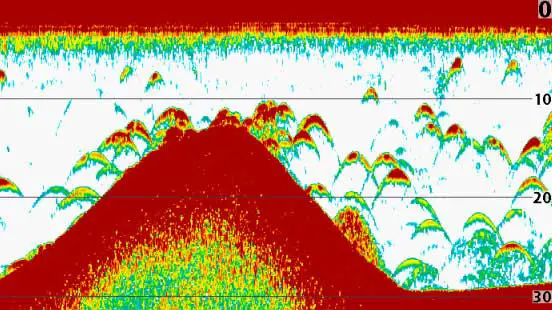
Though information technology might be a hassle trying to place rocks and plants from arches, with fourth dimension, yous'll become the hang of how to apply and understanding your fishfinder images to identify structures and classify fish based on their location and size.
Judging Fish Size
As earlier said, a bigger arch means a bigger fish. Just there'southward more to this as this may not exist the case in every situation. We are going to analyze this based on the thickness, length, and fullness of the arches.
In the epitome the black vertical lines show how long the fish is under the transducer and the greenish lines evidence the thickness of the fish curvation.

Fish Arch Width
And so, if the fishfinder doesn't show y'all the actual length of a fish, can it then show y'all the arch width?
Yes, you're likely to get the actual size of the fish is y'all look at the width of the fish curvation.
Here'southward the idea:
Ever wait at the thickness of the arch instead of the size. If the fishfinder gives a render of a full arc, and so information technology is likely to exist a big fish. And so if you lot become a return of school of fish of the same size, you tin can easily spot out the biggest one with the thickest size.
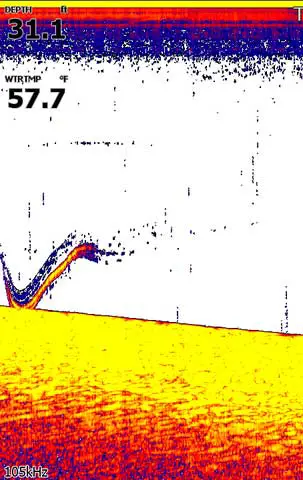
On this screenshot is a vii.v lb. northern state highway, you can see when Doctorsonars set the hook and started bringing him to the surface.
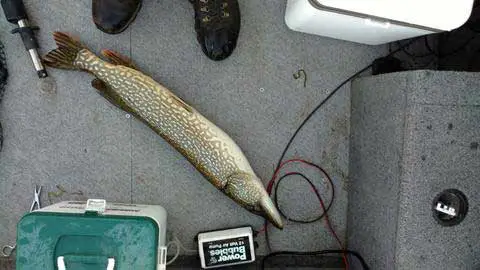
Via: Doctorsonar.com
Half Or Full Fish Arches

The arches on your fishfinder can either be full or half arches. Your fishfinder screen will display a full arch if the fish swims to the entire sonar cone. But it will show a half arch if the fish only swims through function of the sonar cone.
The almost important affair to continue in mind is that a one-half curvation doesn't necessarily hateful a small fish. In that location are withal high chances it could be a big fish.
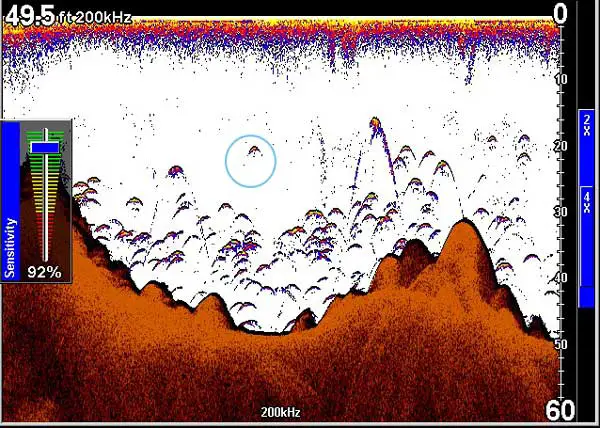
So, the size of the arch doesn't indicate whether it is a big or modest fish. What we recommend you go on an centre for is the thickness of the arch as this is the best way to know whether it is a big fish or non.
Finding Baitfish on Your Fish Finder
Baitfish will display on your fishfinder every bit dots, dashes or fifty-fifty lines. A group of baitfish could often be seen in assurance and are always suspended in the water.
You will also see them in a xanthous color, than in green color of vegetation.
Spotting A Trophy Fish On Your Fish Finder Brandish
The best mode to locate a trophy fish is to look at the previous tip we dropped before. The best indication to know that you've seen a bigger fish is to always wait at the width/thickness of the fish arch. It doesn't really matter if the arch is total or one-half--the principal indication you lot should be looking at is the thickness of the Arch.

Identifying Different Types of Underwater Structure
By understanding sonar and interpreting the display, you can read the depth, determine the bottom contour of underwater structure to help you marking fish. And a cool feature that tin give you a broad view into this is the depth finder feature.
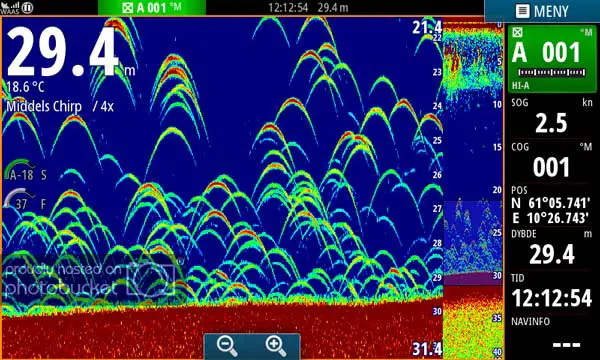
The depth finder on a transducer lets you lot know the depth of the h2o underneath your gunkhole. It likewise tells you the type of fish to expect in that river. Usually, the depth finder feature can easily exist seen in most fishfinders on the height left corner of the screen. It works, using meters instead of feet every bit its calibration of measurement.
Aside from this, the depth finder feature does a off-white Job in showing y'all water temperature to help you know the type of fish you're going to take hold of.

So, always brand sure you lot're trolling or scrolling your fishfinder at a deadening speed in order to get an authentic view of the bottom contour. With this, you volition be able to identify a drop-off. And if you practise, ensure you scan that expanse once more by switching from the wide beam scan to a narrow axle scanning.
This will give you a more accurate picture show of the profile alter, and also help you avoid any 'dead zones' while scanning.

Too, if you're reading a deeper sonar, a bathymetric mapping system will come in handy in helping you create colour-coded underwater contour maps. Bated from this, these maps will also display depth changes, and drib-offs and bear witness you lot the best spots underneath your boat.
Another tip to go on in heed when fishing in a larger surface area is to set a depth alarm to let you know when you reach a given depth range. This volition let you to paddle over shallow waters with less hassle and aid you place a range of species like predators.
Vegetation And Weeds
There are times you lot will desire to choose areas with vegetation and plants every bit your potential areas to cast. But like looking for logs, your fishfinder will display a sentry render or vertical lines on your fishfinder screen when you crash-land in areas with vegetations.
Depressions
If you desire to spot depressions when you are bother fishing, brand sure you watch out for tiny, v-shape dips in the bottom contour as you stroll or reel.
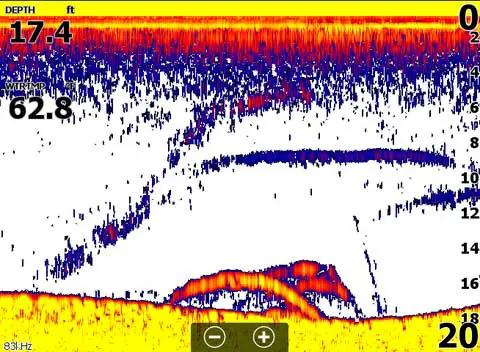
Points
Yous can easily spot points since they are more gradual than driblet-offs. To get an accurate reading of how steep the incline is, ensure you're reeling or strolling at a steady speed.
Too, make sure y'all scan with a narrow sonar axle to accept a clear reading of humps and shelfs, which a wider beam might fail to selection Upwardly.
And Judging bottom Types and Hardness
How practise y'all read a 2D sonar fishfinder to determine the type and hardness of the lesser underneath you? Here a few things to continue in mind.
Thickness
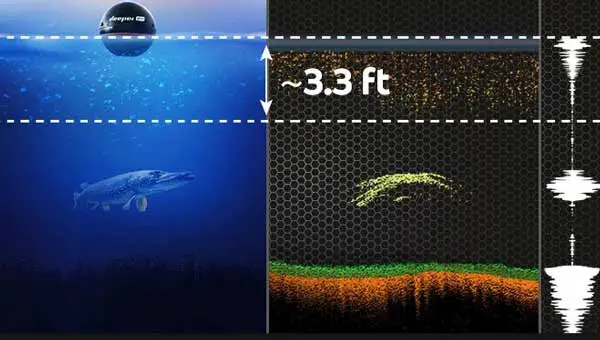
As earlier said, one time your fishfinder returns, a stronger echo, information technology so displays a thicker, bold line. Meaning, the bottom of the water information technology encounters is less porous and a lot harder.
Just what about if the transducer displays a thin, light line? Then it is showing you lot a softer h2o bottom like clay.
Colour and"2d Returns"
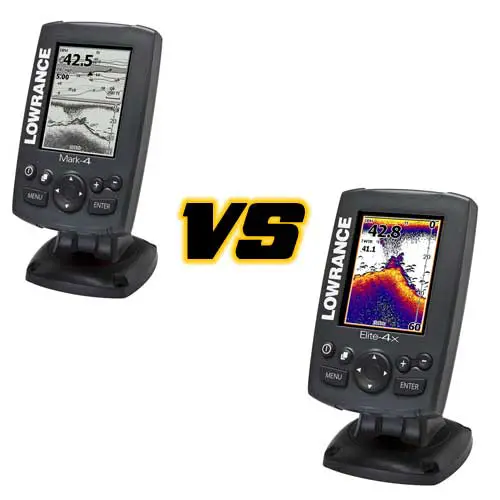
Another thing yous demand to understand virtually fishfinders is they do come in either colour or Grayscale( black&white).
Models with colored fishfinder will display loftier and dark colour if the echoes returned by the transducer are powerful. In other words, if the transducer returns a stronger repeat, then fishfinder will display a stronger or darker color.
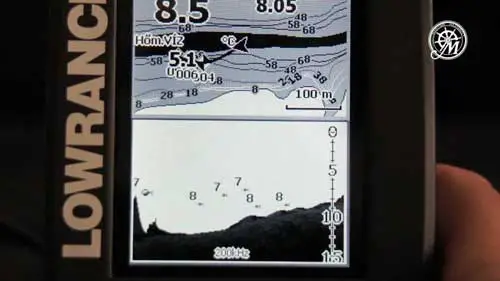
Darkest colour fishfinder
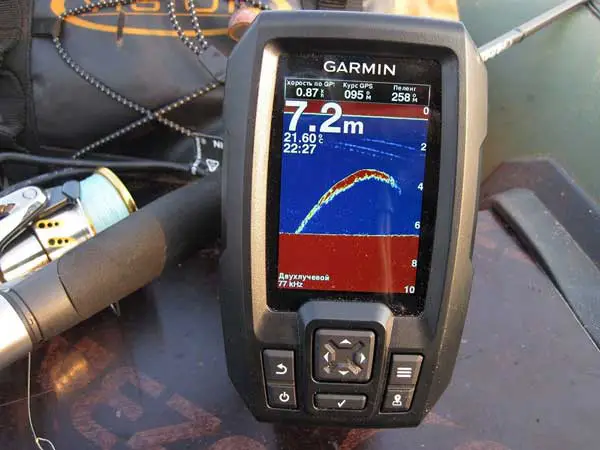
Colored fishfinder
The darkest colour your fishfinder will encounter will exist the returns it gets from details like seabed or the lesser of the h2o.
FAQ:
How To Read A Lowrance Fish Finder Screen?
Reading your Lowrance fishfinder screen is very like shooting fish in a barrel and straightforward. Once yous set it up and running, the next thing you will see is a display of metric and numerical value in the upper left corner.
This volition let y'all know the water depth underneath your boat. Also, ensure to set the automatic mode active to give a precise value of both boat speed and temperature.
Check out this guide about " How To Read A Lowrance Fish Finder " for a more in-depth guide.
How To Read A Garmin Fish Finder Screen?
The Garmin fish finder is a unique unit that utilizes sonar and sound navigation techniques to catch fish in the h2o by receiving reflected pulses gotten from sound energy. And then, with this device, yous will be able to read the info from the reflected sound to find a school of fish underneath the water hands.
We have prepared a video to guide you to know how to use the Garmin fish finder efficiently.
How To Read A Humminbird Fish Finder?
Reading a Humminbird Sonar fish finder is pretty easy. Information technology offers a user-friendly interface coupled with the utmost simplicity in listen. Featuring a digital display screen, you lot tin read information either through the graphical or numerical display.
All this provides y'all with the h2o depth, a articulate picture of bottom profile and even fluctuations in water temperature. As a non-tech savvy, you are going to acquire all you demand to know to use your hummingbird-like a pro.
Here is an excellent video for this
How to Read A Simrad Fish Finder?
The Simrad is the best fishfinders with an intuitive design. It offers a faster and responsive touchscreen, compared to that of Lowrance or Garmin.
To back up this hype, this unit comes with a high-end features, extensive networking, like radar back up, ForwardScan, TripIntel, and a host of other cool features to make your fishing feel a breeze. Here is a short video of how to read a less expensive fish finder like Simrad.
How to Read a Side Imaging and Down Imaging Fishfinder Screen?
Down imaging is probably different from the traditional sonar we are mostly used to. While fish may look the same with a 2D sonar, fish do appear smaller on side imaging because information technology features a downwards axle that comes every bit a narrow slice of the h2o column.
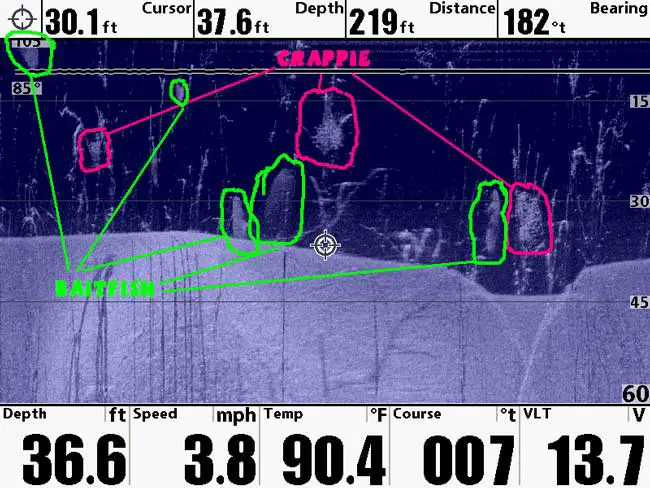
So you're likely to meet something similar Crappie looking like circles, or small ovals. Spotted bass will stack each other while schools of bass will disperse on the bottom.
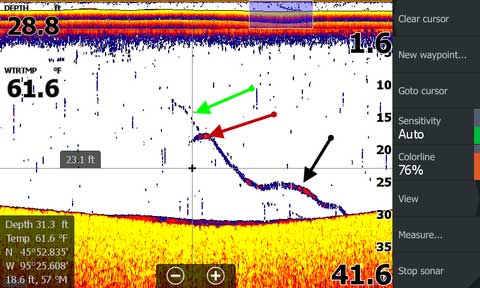
That said, you will be able to view hard lesser on Downwardly Imaging as a little brighter soft bottom, with a thicker band of colour nether it.
Side Imaging Sonar, on the other manus, offers beams on the side to give you brighter returns on fish. It too displays sonar shadows to let yous know if a fish is off the lesser of the water. Then knowing the altitude with the shadow and the fish will let you know how suspended the fish are.
Our Vedict
Fish finders are lovely machines that allow you lot to quickly discover fish to make your fishing experience a total joy. I promise this article was helpful and gave you an insight on how to read a fishfinder.
If you have any question near this, you lot can leave a comment down below.
Source: https://fishfinderbrand.com/how-to-read-fish-finder-screen/
0 Response to "How to Read a Garmin Fish Finder"
Post a Comment